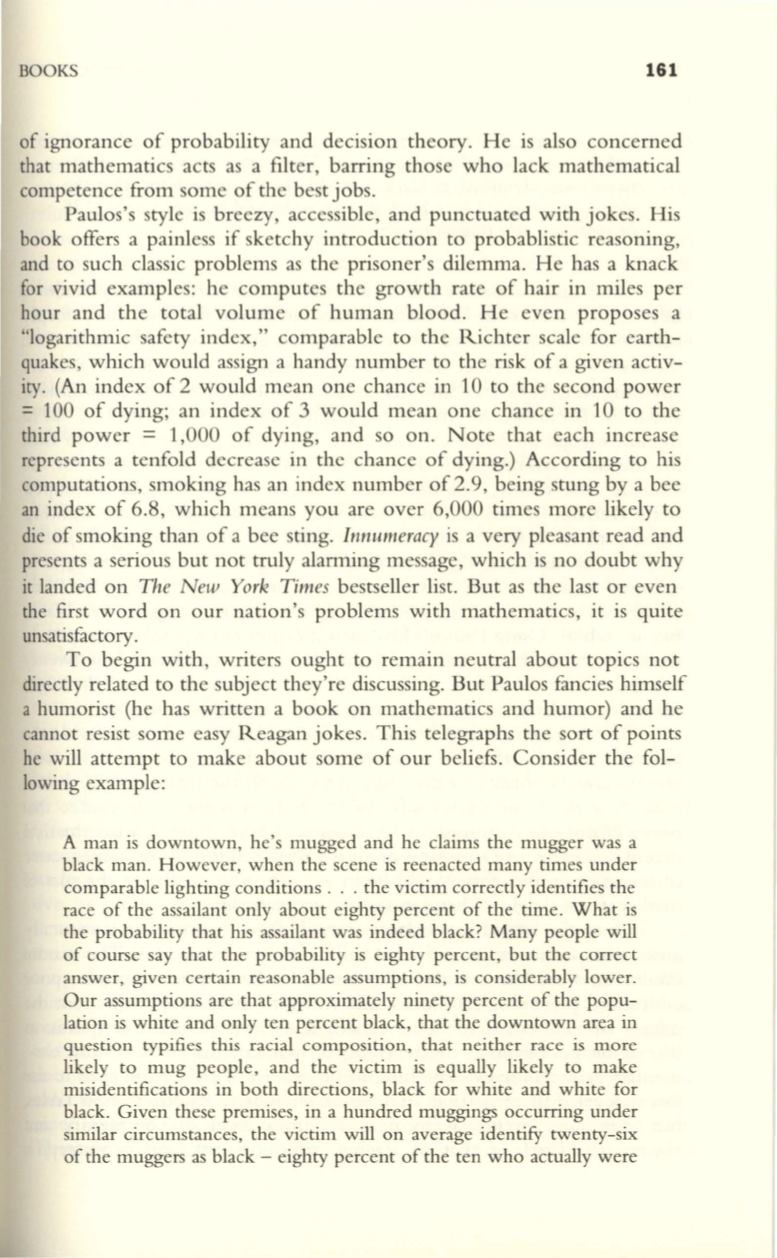
BOOKS
161
of ignorance of probability and decision theory. He is also concerned
that mathematics acts as a filter, barring those who lack mathematical
competence from some of the best jobs.
Paulos's style is breezy, accessible, and punctuated with jokes. His
book offers a painless if sketchy introduction to probablistic reasoning,
and to such classic problems as the prisoner's dilemma. He has a knack
for vivid examples: he computes the growth rate of hair in miles per
hour and the total volume of human blood. He even proposes a
"logarithmic safety index," comparable to the Richter scale for earth–
quakes, which would assign a handy number to the risk of a given activ–
ity. (An index of 2 would mean one chance in 10 to the second power
=
100 of dying; an index of 3 would mean one chance in 10 to the
third power
=
1,000 of dying, and so on. Note that each increase
represents a tenfold decrease in the chance of dying.) According to his
computations, smoking has an index number of2.9, being stung by a bee
an index of 6.8, which means you are over 6,000 times more likely to
die of smoking than of a bee sting.
Innumeracy
is a very pleasant read and
presents a serious but not truly alanning message, which is no doubt why
it landed on
The New York Times
bestseller list. But as the last or even
the first word on our nation's problems with mathematics, it is quite
unsatisfactory.
To begin with, writers ought to remain neutral about topics not
directly related to the subject they're discussing. But Paulos fancies himself
a humorist (he has written a book on mathematics and humor) and he
cannot resist some easy Reagan jokes. This telegraphs the sort of points
he will attempt to make about some of our beliefs. Consider the fol–
lowing example:
A
man is downtown, he 's mugged and he claims the mugger was a
black man. However, when the scene is reenacted many times under
comparable lighting conditions ... the victim correctly identifies the
race of the assailant only about eighty percent of the time. What is
the probability that his assailant was indeed black? Many people will
of course say that the probability is eighty percent, but the correct
answer, given certain reasonable assumptions, is considerably lower.
Our assumptions are that approximately ninety percent of the popu–
lation is white and only ten percent black, that the downtown area in
question typifies this racial composition, that neither race is more
likely to mug people , and the victim is equally likely to make
misidentifications in both directions, black for white and white for
black. Given these premises, in a hundred muggings occurring under
similar circumstances, the victim will on average identify twenty-six
of the muggers as black - eighty percent of the ten who actually were


